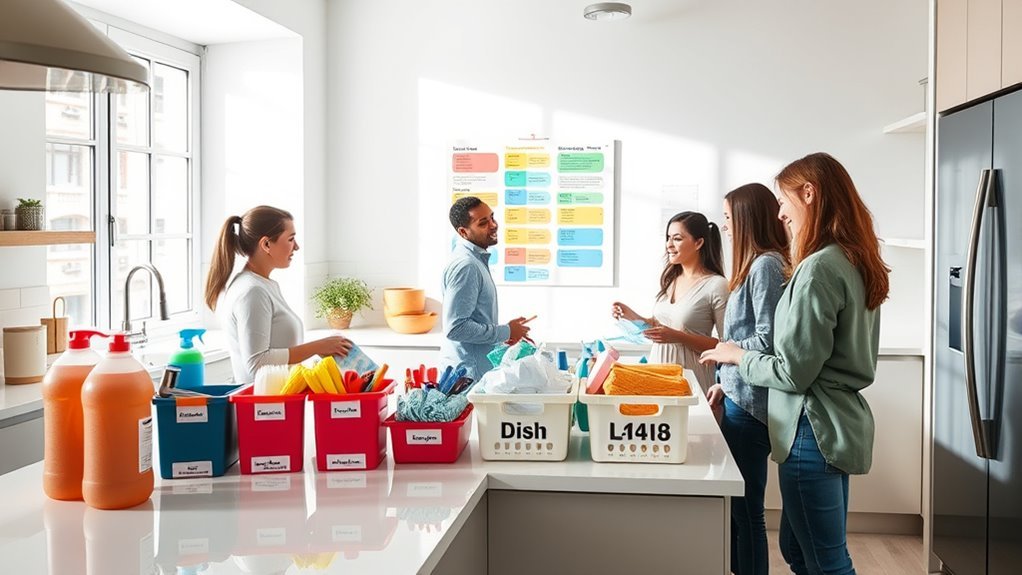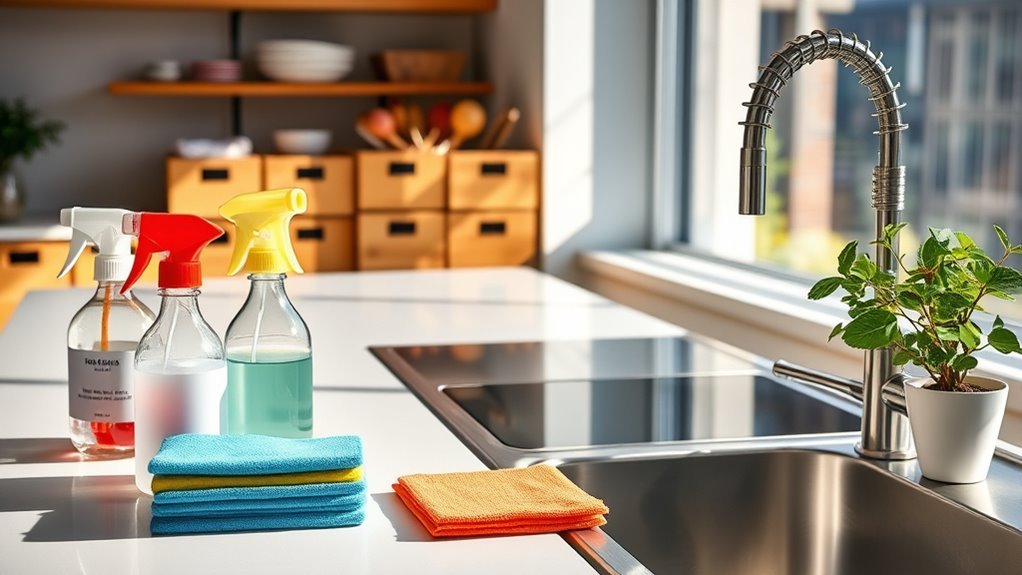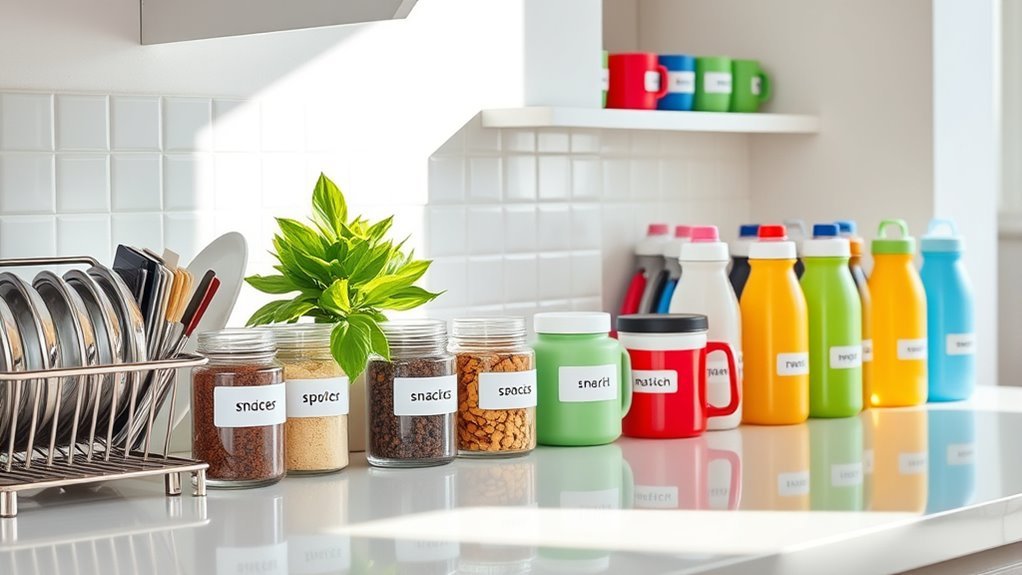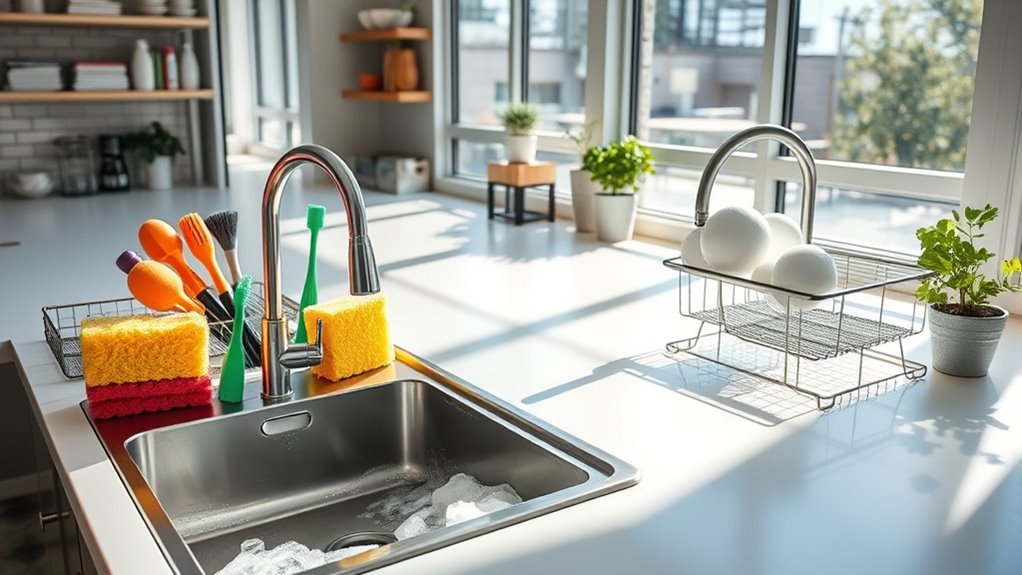Tips for Cleaning a Shared Co-Working Kitchen
To keep your shared co-working kitchen clean, start by setting clear cleaning duties and a flexible schedule everyone agrees on. Provide easy access to supplies like dish soap and wipes, and encourage immediate cleanup after use to avoid buildup. Use labels for personal items and post simple reminders near the sink. Foster respect through good communication and occasional check-ins. Regularly review and adjust practices to fit your group’s needs. Following these simple steps will help maintain a tidy, welcoming space, and there’s more on how to optimize this upkeep.
Establish Clear Cleaning Responsibilities

Before messes pile up, it’s important to establish clear cleaning responsibilities in your shared co-working kitchen. You want to enjoy your freedom without stressing over who should clean what. Start by defining straightforward cleaning protocols that everyone agrees on. This way, responsibility sharing becomes natural and fair, preventing confusion or resentment. When everyone knows their role, the kitchen stays tidy without constant reminders. You don’t have to micromanage or feel chained to dirty dishes. Instead, responsibility sharing creates a smooth flow where each person does their part effortlessly. Clear cleaning protocols empower you and your coworkers to maintain a pleasant environment, so you can focus on your work and freedom, not on cleaning disputes or messes piling up.
Set Up a Cleaning Schedule
Once everyone knows their cleaning roles, the next step is setting up a cleaning schedule to keep things organized and consistent. A well-planned cleaning rotation guarantees no one feels burdened, and the kitchen stays spotless without constant reminders. You can create a simple weekly or biweekly calendar, assigning specific tasks and days to different people. This method spreads responsibility evenly and promotes a sense of shared ownership. By sticking to your agreed schedule, you’ll maintain kitchen maintenance effortlessly, preventing messes from piling up. Remember, the goal is freedom from chaos—not strict rules—so keep the schedule flexible enough to accommodate everyone’s flow while still keeping the kitchen inviting and hygienic for all.
Provide Cleaning Supplies and Storage

A well-stocked supply area makes it easy for everyone to keep the kitchen clean. Make sure you provide essential cleaning supplies like dish soap, sponges, paper towels, and disinfectant wipes in a centralized spot. Choose storage solutions that are accessible and simple—open shelves or labeled bins work great. This way, everyone can grab what they need without hassle or delay. Keep the area tidy by regularly refilling supplies and encouraging users to return items after use. When cleaning supplies are organized and visible, it empowers you and your coworkers to take responsibility without waiting for someone else. With smart storage solutions, maintaining a fresh kitchen becomes effortless, giving you more freedom to focus on your work rather than the mess.
Encourage Immediate Cleanup After Use
You should get into the habit of washing your dishes right after using them to keep the kitchen tidy. Clearing countertops immediately prevents messes from piling up and makes the space welcoming for everyone. This simple routine helps maintain a clean and efficient shared kitchen.
Prompt Dishwashing Habits
Everyone benefits when dishes get washed right after use. By developing prompt dishwashing habits, you help keep the kitchen inviting and ready for the next person, making everyone’s day smoother. When you clean your dishes immediately, you reduce clutter and prevent build-up, which means less stress for all. This simple act encourages teamwork without the need for reminders or rules. It’s about respecting shared space and valuing each other’s freedom to work and relax without hassle. Remember, prompt dishwashing isn’t just about cleanliness—it’s about creating a cooperative environment where responsibility is shared naturally. So, take a moment after eating to wash your dishes. You’ll help maintain a kitchen that everyone can enjoy freely and comfortably.
Clear Surfaces Immediately
Although it might seem easier to leave your workspace for later, clearing surfaces immediately after use keeps the kitchen tidy and ready for the next person. Immediate cleaning isn’t just about hygiene—it’s about respecting shared freedom and maintaining smooth surface organization. When you clear your area right away, you help everyone enjoy a clutter-free space. Here’s how to make it a habit:
- Wipe down any spills or crumbs as soon as you finish to prevent buildup.
- Put away all items, including utensils and containers, so surfaces stay open and accessible.
- Check around your spot for anything left behind and tidy it up before you leave.
Implement a Labeling System for Personal Items

You’ll want to create clear naming conventions so everyone’s items are easy to identify. Using color-coded labels can help keep things organized and reduce mix-ups. This simple system makes it easier to respect personal belongings and maintain a tidy kitchen.
Clear Naming Conventions
A simple labeling system can save hours of confusion and prevent mix-ups in a shared co-working kitchen. To keep things free-flowing and easy, follow these naming guidelines when labeling your personal items:
- Use clear and consistent cleaning terminology to define each item—think “coffee mug” or “lunchbox” rather than vague phrases.
- Keep labels concise but specific enough to avoid ambiguity, like including your initials alongside the item name.
- Stick to easy-to-read fonts or handwriting to guarantee everyone understands the labeling without guessing.
Color-Coded Labels
Using color-coded labels can make identifying personal items in a shared kitchen quick and effortless. By implementing a simple color coding system, you’ll instantly know which items belong to whom without confusion or awkward questions. Choose vibrant, distinct colors for each person or team, and apply labels to mugs, containers, and utensils. Don’t forget to pick labels designed for label durability—they should withstand frequent washing and handling without fading or peeling. This way, you keep your system reliable and your items clearly marked. With this approach, you gain the freedom to focus on your work, not on tracking down your coffee cup. A well-maintained color coding system promotes respect and cleanliness effortlessly, making your shared kitchen a more enjoyable space for everyone.
Promote Proper Waste Disposal and Recycling
Although it might seem like a small detail, promoting proper waste disposal and recycling in a shared co-working kitchen plays an essential role in keeping the space clean and environmentally friendly. You can encourage your community to embrace waste segregation by clearly marking bins for compost, recyclables, and trash. To make it easier and motivating, consider these steps:
- Place visible labels and instructions near each bin to guide proper sorting.
- Offer recycling incentives, like recognition or small rewards, to boost participation.
- Regularly remind everyone about the importance of responsible disposal through brief messages or meetings.
Conduct Regular Deep Cleaning Sessions
Schedule at least one deep cleaning session each month to keep your shared co-working kitchen spotless and hygienic. Deep cleaning techniques go beyond daily tidying, tackling hidden dirt and grime in appliances, vents, and corners. When you organize these sessions, everyone shares the load—embracing shared kitchen responsibilities guarantees no one feels overwhelmed. You can rotate tasks, so each person gets a break while maintaining fairness. Use effective tools like steam cleaners and eco-friendly disinfectants to refresh the space without harsh chemicals. By committing to regular deep cleaning, you preserve a healthy environment that supports your freedom to work and socialize comfortably. Remember, a truly clean kitchen reflects a community that respects both individual freedom and collective care.
Use Signage to Remind Users of Cleanliness
You’ll want to place clear and visible signs around the kitchen to keep cleanliness top of mind. Friendly reminder messages can encourage everyone to clean up after themselves without feeling nagged. These simple prompts help create a respectful and tidy shared space.
Clear and Visible Signs
When sharing a co-working kitchen, clear and visible signs play an essential role in keeping the space clean. You want to maintain freedom while respecting kitchen etiquette, and well-placed visual reminders make that easier. Here’s how to do it effectively:
- Place signs at eye level near sinks and countertops to prompt immediate action.
- Use bold, simple language that highlights key tasks like wiping spills or washing dishes.
- Choose durable materials and bright colors to guarantee signs catch attention and last.
These signs act as gentle nudges, encouraging everyone to contribute without feeling monitored. By integrating clear visual reminders, you create a cooperative atmosphere where cleanliness is a shared value, allowing all users to enjoy the kitchen freely and responsibly.
Friendly Reminder Messages
Anyone using a shared kitchen benefits from friendly reminder messages that gently encourage keeping the space tidy. These messages promote community etiquette and emphasize shared responsibility, making everyone feel respected and free to enjoy the kitchen. You can use creative, positive signage to nudge users without sounding bossy.
Here’s a quick guide for effective reminder messages:
| Message Type | Tone | Example |
|---|---|---|
| Polite Reminder | Friendly | “Please clean as you go!” |
| Motivational | Encouraging | “Together, we keep this space fresh.” |
| Humorous | Lighthearted | “Dirty dishes are not a good look!” |
| Visual Cue | Clear | Icons for wiping counters |
| Community Focus | Inclusive | “Our kitchen, our responsibility.” |
Use these to help everyone embrace freedom with respect.
Foster a Culture of Respect and Cooperation
Although cleaning a shared kitchen can sometimes feel like a chore, fostering a culture of respect and cooperation makes the process smoother for everyone involved. You want to create an environment where freedom and responsibility coexist, encouraging everyone to pitch in. Here’s how you can do it:
- Emphasize team building by organizing casual meetups or quick check-ins to build rapport.
- Use clear communication strategies—like shared calendars or group chats—to set expectations and reminders.
- Recognize and appreciate contributions openly, which motivates continued participation.
Monitor and Adjust Cleaning Practices as Needed
Since habits and needs can change over time, you’ll need to regularly monitor and adjust your shared kitchen’s cleaning practices to keep things running smoothly. Establish a feedback loop where everyone can share honest thoughts, so issues get spotted and fixed fast. Conduct cleaning audits to identify what’s working and what’s not, then tweak the routines as needed. This flexible approach lets you keep the kitchen fresh without feeling stuck in rigid rules.
| What to Monitor | How to Adjust |
|---|---|
| Frequency of cleaning | Increase or decrease based on usage |
| Common mess spots | Add targeted cleaning steps |
| User feedback | Address concerns promptly |
| Supply levels | Restock or reduce waste |
Frequently Asked Questions
What Are the Best Eco-Friendly Cleaning Products to Use in a Co-Working Kitchen?
Imagine your cleaning routine as a refreshing change, not a storm of chemicals. You’ll want to reach for natural alternatives like vinegar, baking soda, and castile soap—these are gentle yet powerful. Sustainable brands like Seventh Generation or Ecover offer eco-friendly options that keep your space sparkling without trapping you in harsh toxins. Choosing these products means you’re embracing freedom: freedom from waste, from harsh chemicals, and from harming the planet.
How Can I Safely Store Food to Prevent Contamination in Shared Fridges?
To prevent contamination in shared fridges, you’ll want to focus on proper food storage. Always use airtight containers or sealed bags to keep your food separate and fresh. Label everything with your name and date to avoid mix-ups. Keep raw and cooked foods apart to stop cross-contamination. Plus, regularly check expiration dates and clean spills promptly. This way, you’re protecting your meals while respecting everyone’s freedom to enjoy a safe, shared space.
Are There Specific Rules for Using Shared Appliances Like Microwaves and Toasters?
When it comes to shared appliances, you’ve got to keep your nose clean to avoid friction. Practicing good microwave etiquette means covering your food to prevent splatters and wiping up spills immediately. For toaster maintenance, always clean out crumbs regularly to prevent fires and avoid jamming it with oversized bread. Following these simple rules lets you enjoy the freedom of shared spaces without stepping on anyone’s toes or causing appliance drama.
What Should I Do if I Notice Someone Repeatedly Leaving the Kitchen Messy?
If you notice someone repeatedly leaving the kitchen messy, it’s best to approach the situation with clear communication strategies. Try having a friendly, non-confrontational conversation, expressing how their actions affect the shared space. Focus on conflict resolution by suggesting mutually agreeable solutions, like setting up cleaning schedules or reminders. This way, you respect everyone’s freedom while maintaining a pleasant environment for all. Keeping things open and honest usually works best.
Can I Personalize My Cleaning Supplies or Should Everything Be Communal?
Imagine a garden where every flower thrives by sharing sunlight and water. In your shared space, personal cleaning supplies can be your unique blossoms, but communal cleaning etiquette is the garden’s soil, nourishing all. You’re free to personalize what you bring, yet respecting shared tools keeps harmony blooming. Balancing your individual touch with collective care guarantees the whole garden stays vibrant and welcoming for everyone.






